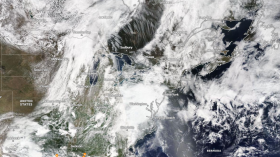Ocean waves slamming on the world's shores release more PFAS into the atmosphere than industrial polluters, raising concerns about environmental contamination and human exposure near coastlines.
The researchers predicted that remobilization via sea spray aerosols emits approximately 49 tons of PFOA and 26 tons of PFOS per year around the world. It was discovered that sea spray levels were hundreds of thousands of times higher than those in the water.
PFAS Exposure

(Photo : Getty Images/Carl Court)
Several years ago, Stockholm researchers discovered that PFAS from ocean waves smashing are discharged into the air near shorelines, where they can travel thousands of kilometers before returning to land.
The new study tested water samples from Southampton, UK, to Chile to see how much sea spray was present when waves crashed. Chemical levels were often higher in the northern hemisphere because it is more industrialized and there is less water mixing across the equator.
According to the authors, these findings are likely to underestimate the contribution of sea spray aerosols to PFAS in the atmosphere because they examined water from the open ocean rather than along the coast. Coastal water is likely to include more dissolved organic matter, which may interact with PFAS and disrupt the remobilization process.
They estimated that 15%-30% of the PFAS released by sea spray ends up on land. They may contaminate coastal drinking water supplies or have an impact on the health of coastal plants.
PFAS exposure from the atmosphere is likely a minor part of the total PFAS exposure coastal areas acquire through household items and drinking water.
According to Ian Cousins, a Stockholm University researcher and the study's lead author, the contaminated spray is likely to damage groundwater, surface water, flora, and agricultural goods near coastlines that are far from PFAS-producing industries.
"There is evidence that the ocean can be an important source [of PFAS air emissions]. It is definitely impacting the coastline," he added.
Read Also: US Sets Limit On Toxic PFAS In Drinking Water, Advocate Groups Calls It 'Historic' Rule
Atmospheric Deposition
PFAS are a group of 15,000 compounds used in dozens of industries to make products resistant to water, stains, and heat.
Although the substances are extremely powerful, they have been associated with cancer, kidney illness, birth deformities, poor immunity, liver difficulties, and a variety of other dangerous conditions.
They are known as "forever chemicals" because they do not degrade naturally and are highly mobile once in the environment, allowing them to flow constantly through the earth, water, and air. PFAS has been found in all parts of the world, from penguin eggs in Antarctica to polar bears in the Arctic.
The data highlight how persistent PFAS are in the environment and how important atmospheric deposition of the chemicals may be, especially for places remote from humans.
"Knowing how much PFAS is in the atmosphere is critical, because things in the atmosphere just move faster and end up with a greater extent of transport," said Cora Young, an environmental chemist at York University in Toronto.
It is unknown what these findings represent for human exposure. Inhalation of PFAS is an issue, but how much of the chemicals are breathed in, as well as air quantities further away from the waves, are unknown.
Related Article: Forever Chemicals PFAS Detected in 'Eco-Friendly' Plant-Based Straws, Study Says
© 2024 NatureWorldNews.com All rights reserved. Do not reproduce without permission.



![Venomous Centipede Could be Game-Changer and Save Lives of People with Kidney Disease [Study]](https://1471793142.rsc.cdn77.org/data/thumbs/full/70407/280/157/50/40/venomous-centipede-could-be-game-changer-and-save-lives-of-people-with-kidney-disease-study.jpg)

